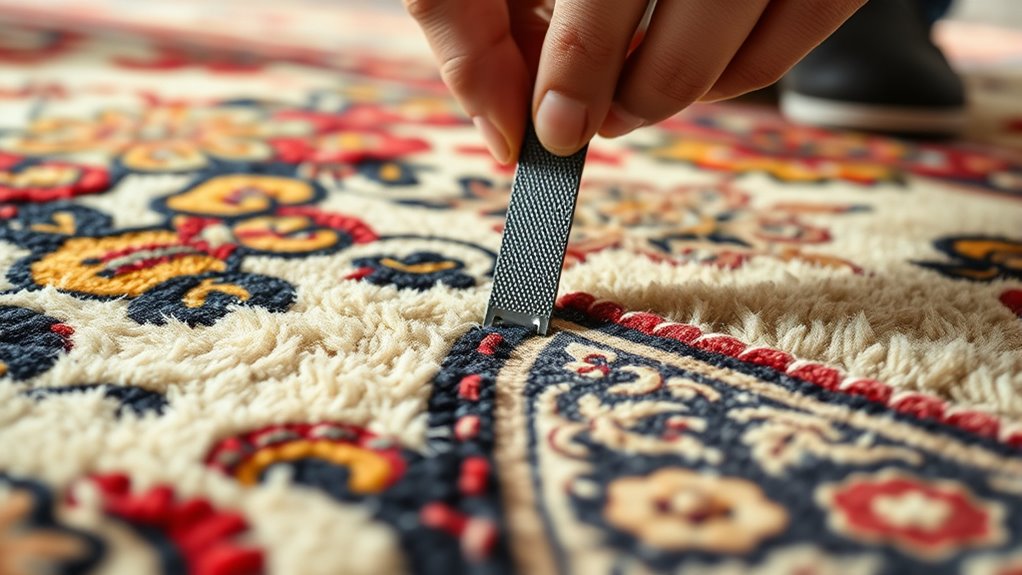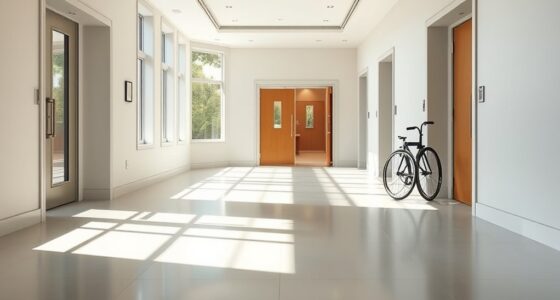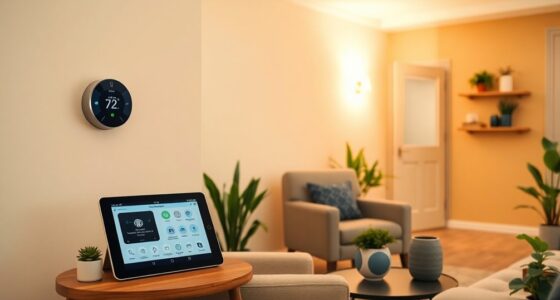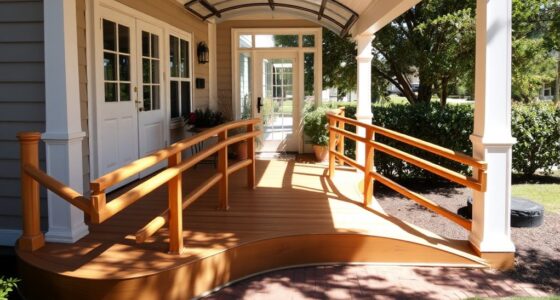To secure rugs and carpets effectively, start by choosing the right non-slip pads or rug grippers suited to your floor type. Make sure to clean the surface thoroughly before applying and position the products at edges or corners to prevent curling or slipping. Regularly check and reapply as needed to keep everything in place. Implementing these simple steps will help keep your rugs safe, sleek, and in place—discover more tips to enhance your setup further.
Key Takeaways
- Use non-slip pads under the entire rug to prevent slipping and protect flooring.
- Attach rug grippers to edges or corners for secure anchoring and to prevent curling.
- Clean surfaces thoroughly before applying securing products for optimal adhesion.
- Choose appropriate materials like latex, rubber, or silicone for durability and traction.
- Regularly check and replace securing products to maintain safety and effectiveness.
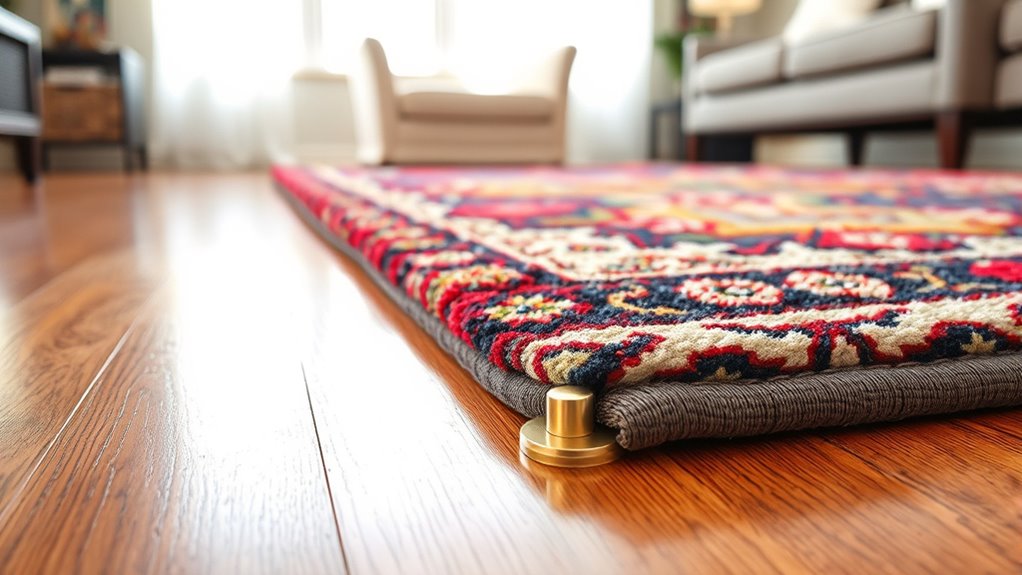
Securing rugs and carpets is essential to prevent slips, trips, and costly damage in your home or workspace. When rugs shift or slide, they create hazards that can lead to accidents or damage to flooring. To keep your space safe and your rugs in place, using non slip pads and rug grippers is one of the most effective solutions. These products are designed specifically to enhance grip and stability, ensuring your rugs stay put no matter how much foot traffic you have. Non slip pads are typically placed under the entire rug, providing a cushioning layer that prevents movement. Rug grippers, on the other hand, are usually attached to the edges or corners of the rug to anchor it securely to the floor. Both options are affordable, easy to install, and work well on various surfaces, including wood, tile, and vinyl.
Securing rugs prevents slips and damage with easy-to-install non slip pads and rug grippers.
When choosing non slip pads, consider their thickness and material. Thin pads may not provide enough grip on smooth surfaces, while thicker pads can add comfort and cushioning. Look for pads made from latex, rubber, or silicone, as these materials offer excellent traction. Rug grippers are especially useful for high-traffic areas or larger rugs that tend to shift more. They come in different styles—some are double-sided tapes, while others are small clamps or velcro strips. Applying rug grippers at strategic points, like each corner or along the edges, helps keep the rug flat and prevents curling or bunching.
Installing these accessories is straightforward. For non slip pads, simply cut the pad to the size of your rug if needed, place it underneath, and smooth out any wrinkles. With rug grippers, clean the floor surface first to ensure good adhesion, then attach the grippers securely to the underside of the rug. Regularly checking these attachments and replacing worn or loose pieces ensures ongoing effectiveness. Using non slip pads and rug grippers not only improves safety but also prolongs the life of your rugs by reducing unnecessary wear and tear caused by sliding or bunching. Additionally, selecting appropriate securing methods that are compatible with your flooring type can further enhance stability.
Ultimately, securing your rugs with the right products minimizes hazards and keeps your space looking neat and tidy. Whether you choose non slip pads or rug grippers, the key is to select the appropriate type for your flooring and rug size. Properly secured rugs stay in place, preventing accidents and protecting your investment. With a little effort upfront, you can enjoy a safer, more comfortable environment every day.
Frequently Asked Questions
What Are the Best Methods for Securing Outdoor Rugs?
To secure outdoor rugs, you should start with proper outdoor rug placement, ensuring the surface is clean and smooth. Use weatherproofing techniques like non-slip rug pads or double-sided tape designed for outdoor use to prevent slipping and movement. You can also weigh down edges with heavy outdoor furniture or stakes, especially during windy days. These methods keep your outdoor rug in place, making your space safer and more comfortable.
How Do I Remove Stubborn Adhesive Residue From Carpets?
To remove stubborn adhesive residue from carpets, start with gentle adhesive removal by applying a mixture of warm water and dish soap. Use a soft-bristle brush to loosen the residue, then blot with a clean cloth. For tougher spots, try rubbing alcohol or a commercial adhesive remover, but test a small area first. Follow up with thorough carpet cleaning to restore your carpet’s look and feel.
Can Securing Rugs Cause Damage to Delicate Flooring?
Think of securing rugs as walking a tightrope—you need balance to avoid damage. Yes, improper use of rug adhesives can harm delicate flooring, but with proper flooring protection, you’re safe. Always choose gentle adhesives, and lift rugs carefully to prevent scratches. When in doubt, test a small area first. This way, you protect your flooring while keeping your rugs securely in place, avoiding costly damage or repairs.
Are There Eco-Friendly Options for Rug Securing Products?
Yes, you can find eco-friendly options for rug securing products. Look for eco-friendly adhesives made from natural ingredients that won’t harm your flooring or the environment. Natural rug fasteners, like non-slip pads made from sustainable materials, also provide a secure grip without toxic chemicals. These options are safe for delicate flooring, easy to use, and help reduce your ecological footprint, making them a smart choice for eco-conscious homeowners.
How Often Should I Re-Secure High-Traffic Carpets?
You should re-secure high-traffic carpets every 6 to 12 months, especially if you notice bunching or slipping. Use proper rug padding to prevent movement and employ effective securing techniques like double-sided tape or adhesive pads. Regular re-securing keeps your carpets safe, prevents tripping hazards, and extends their lifespan. Keep an eye on areas with heavy foot traffic, and re-secure promptly to maintain a tidy, secure surface.
Conclusion
Remember, a well-secured rug isn’t just about safety—it’s about creating a peaceful space where every step feels steady and sure. When you take the time to keep your carpets in place, you’re gently nurturing a sense of harmony in your home. It’s a subtle act that speaks volumes about care and attention. So, embrace the small details; they often hold the key to a more comfortable, worry-free environment.
